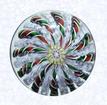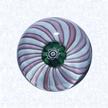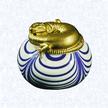Other Techniques - Crowns, Swirls, and Marbries
Crowns, Swirls, and Marbries
Three techniques that usually feature a central millefiori cane are crowns, swirls, and marbries.

Red, White, and Green Crown
Saint Louis, circa 1845-55Crowns
The Saint Louis factory perfected the crown weight. From the central millefiori cane radiate alternating colored twists and filigree. The basis of the weight is a hollow blown center. This molten-hot center was lowered onto a mold arrangement of twists and filigree rods, which molded itself to the globe shape. This was dipped into another layer or layers of clear glass. The Barker Collection contains four Saint Louis crown weights.

Pink and White Swirl Miniature
Clichy, circa 1845-55Swirls
All eight of the swirl weights in the Barker Collection were made by Clichy. They feature center florets. The glassmaker lowers a gather of background glass, perhaps clear, into a mold holding straight rods of alternating colors and the center floret. After the rods adhere to the gather, the gather is twisted to make the swirl pattern. Popular colors were pink, blue, and white.

Cast-molded, gilded salamander
coiled atop a hollow blown
opaque white weight with
blue marbrie festooningMarbries
Saint Louis also specialized in Marbries. White glass is blown into a globe shape. A repeat swag design of colored glass is applied to the surface. The Barker Collection's marbrie features, instead of a floret, a gilded cast-molded salamander.










